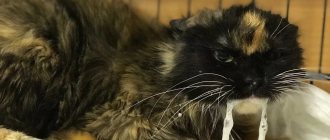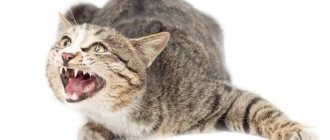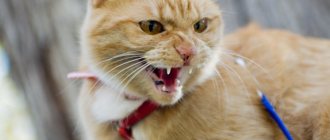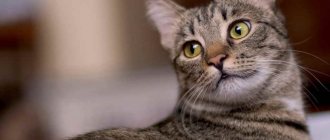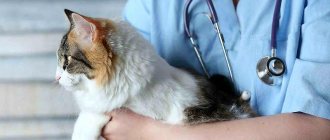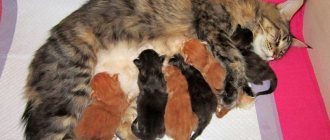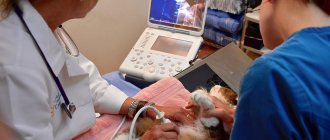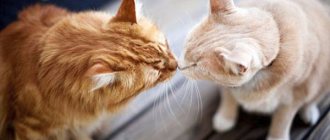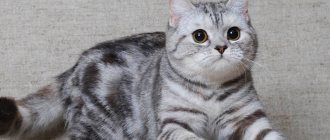Many people make a lot of efforts to get rid of extra pounds, but for some reason they are touched by the sight of a fat, imposing cat. But the problem of excess weight for cats is as acute as for their owners. Excessive fat deposits in the subcutaneous tissue, various organs and tissues are the result of overfeeding, low physical activity and threaten the development of many dangerous diseases, disability and even death of the animal. We must understand that obesity in cats is not a reason for delight and tenderness, it is a serious pathology. A sick animal needs proper treatment. From this article you will learn how to determine if a pet is obese, what to do to get rid of excess weight, and how to deal with the complications that this disease entails.
Types of obesity
In cats (as in people), depending on the causes, there are two types of obesity - primary and secondary.
- Primary obesity is also called nutritional obesity. It is based on incorrectly formed dietary preferences, leading to an energy imbalance in the body, as well as hereditary-constitutional factors (inheritance of a tendency to be overweight from ancestors). This type of obesity in cats is an independent disease that can be treated.
- Secondary obesity is called symptomatic. It is only a symptom of a malfunction of other organs (most often the brain or endocrine glands), as a result of which the metabolic rate changes and a pathological appetite appears. In this case, it is not obesity itself that needs to be treated, but its root cause.
Signs of an overweight cat
The first thing you need to pay attention to is the weight. For cats, there is no universal standard by which one can say whether a pet is now normal weight or overweight. These indicators are determined depending on the breed of the animal and its age.
For convenience, you can use this table to check if your cat is obese:
| Animal age | Outbred | British breed | Maine Coon | |||
| cat | cat | cat | cat | cat | cat | |
| 4 months | 2.3-3.2 kg | 2.2-2.8 kg | 2.1-3.9 kg | 1.7-2.5 kg | 3-3.8 kg | 2.7-3.6 kg |
| 10 months | 3.1-4.4 kg | 2.4-4 kg | 4.1-6.7 kg | 2.8-4.4 kg | 4.8-7.2 kg | 4.3-6.5 kg |
| 1 year | 3.5-5 kg | 3.5-4.5 kg | 4.5-7 kg | 3.1-4.6 kg | 5.4-8.8 kg | 4.5-8.3 kg |
*The data indicated in the table is indicative. When determining normal weight, it is important to take into account not only breed and age, but also the level of physical activity. Exceeding the specified data by 15-20% is the norm. In any case, it is worth contacting a professional veterinarian in Moscow to determine what weight is normal for your pet and what is excessive.
Other signs that indicate your cat is obese:
- Can't feel the ribs.
If your pet is of normal weight, then the contours of the ribs are easy to feel. Try it now. Carefully feel the ribs, and if this is difficult to do or is not possible at all, then this directly indicates that the animal is overweight.
- It is not noticeable how the pet breathes.
Breathing in a cat that is overweight is almost imperceptible. Another thing is an animal with normal weight. If it lies on its side, you will be able to see all the breathing movements (inhalation, exhalation).
- Waddle".
A waddling gait is another sign of obesity (unless your cat is pregnant or sick). Watch how your pet walks. Does it shift from paw to paw? If yes, then this is a reason to be wary and consult a veterinarian.
Causes
There are several main reasons why cats develop obesity:
- energy imbalance (predominance of the amount of incoming energy over the energy expenditure of the body);
- lipid imbalance (the predominance of the amount of fat consumed over the body’s ability to burn it);
- metabolic disorders and hormonal imbalances in the body;
- burdened heredity.
Owner behavior
Caring for a pet during its treatment requires changes in the behavior of the owner himself. He should set an example, in particular, forget about often sitting in a chair or lying in bed. You will have to work with your pet more often, captivating him, not allowing him to constantly sleep or even just lie down. It's good when children in the family involve the cat in their games. At the same time, you should not limit her movement.
A cat has no business being in the kitchen or near the table during family meals. It is necessary to immediately take it to its place. The animal should receive food only in a separate area, remote from both the kitchen and its “bedroom”. “Begging” and accepting food from the common table should be strictly prohibited. Feeding should be done only according to the established regime and diet. No extra treats. Affection and encouragement should not be associated with food. The remaining food in the bowl is removed after feeding.
It is necessary to regularly monitor the weight of your pet. Weighing should be done daily, recording the readings. It is important to identify the general trend of changes. If a slight but stable weight loss is observed, treatment must be continued. If no effect is detected, you should contact your veterinarian again. You may have to change your approach to diet and switch to special foods.
Special care is necessary in the presence of pathological internal causes of obesity associated with chronic diseases. In this case, the doctor must accurately diagnose the pathology and prescribe medication. The owner’s task becomes the timely administration of prescribed medications.
Provoking factors
There are also certain factors, the presence of which provokes obesity in cats:
- overfeeding the animal;
- low physical activity;
- unbalanced diet;
- sterilization or castration of animals;
- endocrinological diseases;
- hormonal therapy and the use of oral contraceptives;
- breed and genetic predisposition;
- senior and old age.
Overfeeding an animal
The most common risk factor for a cat leading to obesity is overfeeding the animal in combination with physical inactivity. By nature, a cat is a predator that must hunt for food, expending a lot of energy.
The problem with most furry pets living in city apartments is their extremely limited living space. The animal is deprived of the opportunity to run around, hunt, and play to its heart's content. In addition, to get food, he does not need to spend a single calorie - he can just come up and eat. Excessive comfort turns out to be evil, not good, for cats.
Overeating can be the result of certain lifestyle features:
- Rivalry between animals when several pets live under one roof.
- Lack of attention from the owners. The cat “eats” its feeling of “abandonment,” uselessness and loneliness.
- Food becomes a constant visual irritant if the owner prefers to constantly pour food into the cat's bowl. As the animal passes by, it sees food and cannot resist eating. As a result, daily feed consumption is many times higher than the average daily requirement.
- Bad habit. If, as a kitten, the animal was fed “to its fullest”, then over time the habit of overeating develops into a need, since the walls of the stomach stretch, accepting more and more.
Unbalanced diet
In obesity, an unbalanced diet is often the trigger. It is as follows:
- Animals are fed cheap feed that contains ingredients that are harmful to health.
- Some owners pamper their cats with food from their table, without thinking that it contains unacceptable amounts of carbohydrates and fats.
- A mixed diet consisting of both dry food and natural products can lead to obesity. When compiling a diet, it is recommended to choose one option: natural balanced nutrition or high-quality dry food. Natural nutrition should be varied and include the required amount of proteins, fats, carbohydrates, minerals and vitamins.
- When using industrial feed, the daily allowance indicated on the packaging in a special table is often exceeded.
Sterilization
After sterilization, hormonal imbalance may occur, which can lead to obesity. Danger exists only if you do not pay enough attention to the animal. The energy that was previously spent on finding a partner and sexual games must now be spent in a different way.
Therefore, the owner of a sterilized cat must ensure that the animal moves a lot, provide it with the opportunity and territory to play, and also use special low-calorie food.
Endocrinological diseases
They are associated with metabolic disorders and hormonal imbalances, which also, under certain conditions, lead to obesity. Such diseases include:
- diabetes mellitus, in which insulin production decreases, its activity decreases, or its perception by tissue cells is impaired;
- hypofunction of the thyroid gland, characterized by a slowdown in metabolism, increased synthesis and accumulation of adipose tissue, and a decrease in physical activity;
- Gastrointestinal pathologies and adrenal dysfunction are also dangerous.
Hormonal therapy and the use of oral contraceptives
This is another reason for serious hormonal imbalances, which are the causes of excess weight. In addition, other health problems, including malignant neoplasms, may occur as side effects.
Breed and genetic predisposition
There are cat breeds whose breed quality is a tendency to be overweight and have an increased appetite. An example is the British Shorthair. A balanced diet is very important for this breed. The diet should consist of specialized feeds with moderate calorie content. If this rule is not followed, obesity will be difficult to avoid.
The tendency to the disease can be inherited. Therefore, when choosing an animal, before purchasing, you should definitely ask the breeders what chronic ailments and abnormalities bothered its parents and earlier ancestors.
Senior and old age
At an older age, the animal’s physical activity gradually decreases and metabolism slows down. Starting from the age of five, it is necessary to especially carefully ensure that the pet maintains an energy balance between the energy received and expended, otherwise obesity in an elderly cat is highly likely to occur.
Symptoms
Every cat owner should know what obesity is and how to correctly identify it in their pet. Obesity is a consequence of metabolic disorders and occurs when weight increases by 20% of the norm according to the breed standard.
When calculating, it is important to take into account the sex and age of the animal. This is due to the fact that young cats during the period of active growth can gain weight and then safely lose it. The same applies to gender - males, as a rule, are much larger than females. The ideal indicator is weight at the age of one year.
The main symptoms of obesity are as follows:
- sagging in the abdominal area;
- fat deposits on the side of the body;
- leisurely gait;
- apathetic state of the pet and drowsiness;
- development of shortness of breath during active physical activity (running, jumping).
A sign of obesity in a cat can be considered the appearance of folds in the ribs and abdomen. By carefully palpating your mustachioed pet, the owner will be able to note the presence of fatty deposits. Also, excess weight is visually noticeable in cats, especially if the cat at the age of 1 year did not have a large build.
Why is obesity dangerous?
Obesity is dangerous because it has many complications. It's not for nothing that they call it a ticking time bomb. After all, it affects not only the subcutaneous tissue. Fat is deposited in blood vessels and internal organs, impairing their functioning. This disease significantly shortens the animal's life. The main complications concern the following internal organs and systems:
- The cardiovascular system. An obese heart cannot withstand the load. It takes a lot of effort to lift and move a heavy body, as does pumping blood through vessels clogged with atherosclerotic plaques. That is why the risk of hypertension, heart attacks and other heart ailments increases several times.
- Diabetes. An incorrectly formulated diet, with a high content of carbohydrates, becomes the cause of many endocrinological diseases, including diabetes. In the later stages, the disease has very serious complications, such as visual impairment, even blindness, as well as the problem of tissue regeneration.
- Arthritis. Too much stress on the joints leads to their deformation and inflammation. The articular cartilage gradually wears out and loses its motor function.
- Obesity takes a toll on the liver. The cells of the organ begin to degenerate into fat cells. Fatty hepatosis leads to disruption of metabolic, barrier, and digestive functions.
- In the presence of other associated factors, obesity significantly increases the risk of developing malignant neoplasms.
If there are several cats in the house
It happens that there are many cats living in a house, but only one of them is obese. In this case, feeding regimes are different. Organization of the process causes some difficulties for breeders.
Veterinarians offer several options for solving the problem. For example, they practice isolated feeding. Cats are given food at the same time, but in different rooms, and are given 15–20 minutes to absorb it. At the end of the meal, check whether all the food has been eaten. What is left is removed until next time or thrown away.
If there are several cats in the house, the task becomes more complicated.
Another way is to place bowls of food for cats of normal weight on the upper floors of the home. At first, it is not easy for overweight animals to get to high-lying food, so their dining room is located on the ground floor.
How to determine if you are overweight
An external examination will help determine the degree of fatness of a pet. Signs of obesity are immediately visible:
- An emaciated cat will have an elongated body with a narrow back, sunken sides and belly, and protruding ribs and hip bones.
- A smooth body without prominent ribs and pelvic bones, which can be easily palpated, indicates normal fatness. The animal has a visible waist - a narrow place in the lumbar region. The abdomen is tucked, the subcutaneous fat layer is small.
- Obesity is indicated by an oval or spherical body. There is no waist. In the area of the spine, costal and pelvic bones there is a thick fatty layer that prevents palpation. You may notice a drooping belly.
But the clearest sign of obesity is weight. Knowing the average normal weight for cats of the corresponding breed, the owner during weighing can easily understand whether the body weight of his pet is much exceeded.
In order to exclude the presence of secondary (symptomatic) obesity, it is necessary to show your pet to a veterinarian. During the diagnosis, it will be clear whether obesity is an independent deviation (which can be corrected), or a symptom of another disease (when the animal will require more serious complex treatment).
Combating a sedentary lifestyle
Correction of the diet should be accompanied by an increase in the animal’s activity.
Important! Cats, compared to dogs, are not marathon runners, but sprinters. This means they are capable of short bursts of activity rather than long walks. This fact is taken into account when creating a weight loss program.
Overweight cats are initially not ready for increased physical activity. In the first week, you can get them to move more by moving the food dishes away from the bed. If the cat is walking in the yard, then the bowls are placed around the house, distributing the entire single meal between them.
Favorite toys - for example, fishing rods - will stimulate a lazy cat. Some animals, like dogs, can bring thrown objects - small rubber toys, pencils (not sharpened ones). If, after a training session, you treat your pet with a small piece of lean meat or a vitamin-rich treat, this will stimulate interest in games.
Feeder ball
It doesn’t matter if the owner leaves the pet alone for a long time. There are many pet products that will encourage him to play independently. Thus, running wheels are on sale, as well as toys-feeders for animals. In order to get food, the pet must work hard physically.
A running wheel is a great way to keep your couch potato cat in shape. In this article on our portal, we’ll look at what types of running wheels for cats are and how to choose the right one for your pet. For handmade lovers, there is a special section on how to make a running wheel with your own hands.
Video – Interactive complexes for cats
Treatment of the disease
Primary obesity must be corrected by lifestyle changes, aimed mainly at introducing a healthy diet and increasing the animal’s physical activity. Let's talk in more detail about the most important steps:
- Review of diet. A special low-calorie diet is introduced, which in no case should be hungry. Otherwise, the effect will be the opposite, since in conditions of hunger the body retains adipose tissue and consumes it last. You can disrupt the functioning of the gastrointestinal tract without solving the problem of excess weight. Nutrition should be complete. Regardless of what kind of food the animal consumes, natural or industrial, the calorie content should decrease very gradually, over 1-2 months. When feeding a natural diet (as general recommendations), it is suggested to give the cat low-fat sea fish or lean meat, fermented milk products, and a limited amount of vegetables.
- Introduction of fractional meals. The cat should eat 5-6 times a day, in small portions. This will improve the digestibility of food. In addition, the cat will not be tormented by hunger, and a good mood is the key to successful treatment.
- Active lifestyle. It is necessary to stimulate the animal to play outdoor games, sometimes even insisting on them if they do not bring him much pleasure. In order to captivate a cat, you need to use the instinct of a hunter and predator inherent in every animal.
- If complications have already appeared, it is necessary to treat them. Particular attention should be paid to maintaining the heart muscle, as it begins to suffer first.
Treatment of symptomatic (secondary) obesity is prescribed by a doctor after examining the patient and is carried out under his close supervision. Treatment tactics depend on the nature of the identified abnormalities.
Feeding an obese cat
You cannot switch your pet to only one type of food (for example, only meat, only cereal, only vegetables). Such diets for cats with obesity are prescribed only in cases where some disease is diagnosed. But losing weight (without health consequences) is unlikely. And exclusively protein diet is harmful to the kidneys. Therefore, feeding should be varied.
It is best if your cat is already eating animal food, switch it to specialized food for overweight people. Almost every brand has these in their assortment and more than one.
If, for ideological or any other reasons, you feed only natural food, then the recommendations are as follows:
- Lean meat (chicken without skin, salt, seasonings);
- Boiled fish;
- Low-calorie and easily digestible cereals (buckwheat, oatmeal), boiled vegetables (but not potatoes, onions and garlic are generally prohibited);
- Cottage cheese, kefir, yogurt with a low fat content or completely low-fat (they are full of calcium).
Once again, feeding an obese cat needs to be balanced - you can’t give just one thing from this list.
Prevention measures
After the problem of obesity is solved, the animal’s predisposition to excess weight will remain. To prevent symptoms from returning throughout his life, it will be necessary to implement preventive measures:
- it is very important not to overfeed the animal;
- Do not mix natural feeding with dry food;
- It is not recommended to give your cat treats from your table;
- you should choose only high-quality premium food;
- it is necessary to ensure that the content of proteins, fats and carbohydrates in the feed does not exceed the recommended standards;
- Before sterilizing an animal, it is necessary to consult a veterinarian to determine whether the animal has a predisposition to obesity and what food is best to choose after surgery.
It is advisable to monitor weight changes by regularly weighing your pet. The cat can be a little heavier or a little lighter, the main thing is that its weight is within the normal range. This will serve as a guarantee of good health for him and a guarantee of high energy potential.
Treatment of obesity in cats
Treatment is approached in a comprehensive manner. A visit to the doctor and laboratory tests will help determine the cause of obesity. If weight gain is caused by a disease, then first they select treatment options - medications, physical therapy methods, and, if necessary, resort to surgical intervention.
A mandatory component of treatment is diet . Inexperienced owners believe that half the portion will be sufficient. However, this is a wrong approach. Malnutrition can transform into persistent meowing. And there is a chance that the family will start feeding the pet in the old way in order to silence it. Don't forget about vitamins.
Feline vitamin deficiency
Attention! Body weight loss should not exceed 1–3% per week. Otherwise, serious health problems may arise.
Weight stabilizes gradually. Sometimes this takes up to 12 months.
If the cause is a disease, appropriate treatment is selected
Diet and food for cats with obesity
Manufacturers have developed special diets for such cats. These are low-calorie dry and wet foods that promote weight loss, including medicinal ones. They also have an increased protein content to maintain muscle mass.
Table 1. Medicinal foods for weight loss.
| Name of food | Package weight, kg/price, rub. | Product Features |
| Advance Obesity Management | 1,5/1130 |
|
| Royal Canin Obesity Management DP42 | 1,5/1300; 0,4/450 |
|
| Proplan OM Obesity Management | 1,5/1200 |
|
After stabilizing the weight, they switch to food that helps maintain shape. The manufacturers listed above also have these products.
Therapeutic foods help stabilize weight
Natural nutrition
The media talk about the miraculous weight loss of the cat Fidget, whose owners put him on a protein diet, giving him only fresh meat and sausages. People are familiar with this diet as the Kremlin diet, or Atkins (naturally, sausages are not included in the diet).
Miraculous weight loss for a cat
Nutritionists are against this method of nutrition, since excess protein affects the kidneys, which are considered the weak point of cats. This results in other problems with the body - fecal poisoning. Therefore, in addition to protein, the diet should include cereals and vegetables.
The cat should be fed as if it were of normal body weight. Approximate diet for an animal 4–5 kg:
- meat (rabbit, poultry, veal, beef) - 70 g;
- cereals cooked in water (rice, buckwheat, corn grits) - 50 g;
- cottage cheese (0% fat) - 30 g;
- boiled vegetables (cabbage (white or cauliflower), carrots, zucchini) - 100 g.
As directed by the doctor, vitamin preparations are given according to the instructions. When the cat's weight returns to normal, reduce the amount of cereals in favor of cottage cheese.
Delicacies from the master's table are taboo
If the cause of weight gain is overeating, the daily portion is not reduced immediately, but gradually, decreasing by a quarter every week until it reaches the standard weight. Nutrition adjustments are made every 1-1.5 months. Be sure to stop feeding foods from your table that are not intended for cats.
